
A pupa is the life stage of some insects undergoing transformation between immature and mature stages. Insects that go through a pupal stage are holometabolous: they go through four distinct stages in their life cycle, the stages thereof being egg, larva, pupa, and imago. The processes of entering and completing the pupal stage are controlled by the insect's hormones, especially juvenile hormone, prothoracicotropic hormone, and ecdysone. The act of becoming a pupa is called pupation, and the act of emerging from the pupal case is called eclosion or emergence.
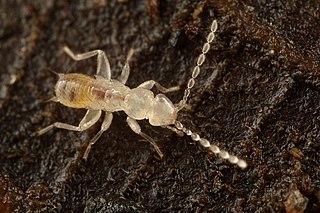
The insect order Zoraptera, commonly known as angel insects, contains small and soft bodied insects with two forms: winged with wings sheddable as in termites, dark and with eyes (compound) and ocelli (simple); or wingless, pale and without eyes or ocelli. They have a characteristic nine-segmented beaded (moniliform) antenna. They have mouthparts adapted for chewing and are mostly found under bark, in dry wood or in leaf litter.

A spinneret is a silk-spinning organ of a spider or the larva of an insect. Some adult insects also have spinnerets, such as those borne on the forelegs of Embioptera. Spinnerets are usually on the underside of a spider's opisthosoma, and are typically segmented. While most spiders have six spinnerets, some have two, four, or eight. They can move both independently and in concert.
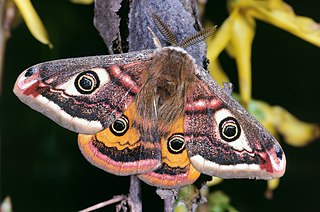
Saturniidae, members of which are commonly named the saturniids, is a family of Lepidoptera with an estimated 2,300 described species. The family contains some of the largest species of moths in the world. Notable members include the emperor moths, royal moths, and giant silk moths.

The order Embioptera, commonly known as webspinners or footspinners, are a small group of mostly tropical and subtropical insects, classified under the subclass Pterygota. The order has also been called Embiodea or Embiidina. More than 400 species in 11 families have been described, the oldest known fossils of the group being from the mid-Jurassic. Species are very similar in appearance, having long, flexible bodies, short legs, and only males having wings.

The Archaeognatha are an order of apterygotes, known by various common names such as jumping bristletails. Among extant insect taxa they are some of the most evolutionarily primitive; they appeared in the Middle Devonian period at about the same time as the arachnids. Specimens that closely resemble extant species have been found as both body and trace fossils in strata from the remainder of the Paleozoic Era and more recent periods. For historical reasons an alternative name for the order is Microcoryphia.
The arthropod leg is a form of jointed appendage of arthropods, usually used for walking. Many of the terms used for arthropod leg segments are of Latin origin, and may be confused with terms for bones: coxa, trochanter, femur, tibia, tarsus, ischium, metatarsus, carpus, dactylus, patella.
Anisembiidae is a family of insects in the order Embioptera, the web-spinners. The family is divided into several subfamilies. It is the largest family of webspinners.

Spiders are air-breathing arthropods that have eight legs, chelicerae with fangs generally able to inject venom, and spinnerets that extrude silk. They are the largest order of arachnids and rank seventh in total species diversity among all orders of organisms. Spiders are found worldwide on every continent except for Antarctica, and have become established in nearly every land habitat. As of August 2022, 50,356 spider species in 132 families have been recorded by taxonomists. However, there has been debate among scientists about how families should be classified, with over 20 different classifications proposed since 1900.

Eumetabola is an unranked clade of Neoptera. Two large unities known as the Eumetabola and Paurometabola are probably from the adelphotaxa of the Neoptera after exclusion of the Plecoptera. The monophyly of these unities appears to be weakly justified.
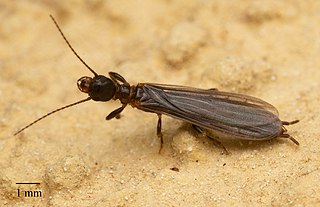
Oligotoma nigra, also known as the black webspinner, is a species of insect in the order Embiidina, also known as Embioptera.
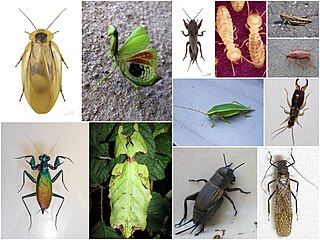
The cohort Polyneoptera is a proposed taxonomic ranking for the Orthoptera and all other Neopteran insects believed to be more closely related to Orthoptera than to any other insect orders. These winged insects, now in the Paraneoptera, were formerly grouped as the Hemimetabola or Exopterygota on the grounds that they have no metamorphosis, the wings gradually developing externally throughout the nymphal stages.
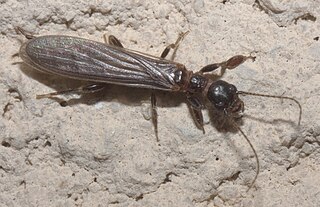
Oligotoma is a genus of webspinners, insects in the order Embioptera, also known as Embiidina. The type species is Oligotoma saundersii and the type locality the Indian subcontinent. The males have wings but the females are flightless. Embiids are recognisable by the enlarged front tarsi, which contain a large number of silk glands that they use to spin the threads they use for building the tubes and galleries in which they live.
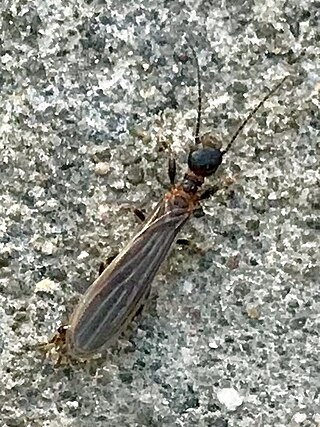
Oligotoma saundersii, commonly known as Saunders' embiid, is a species of webspinner, an insect in the order Embiidina, also known as Embioptera.

Haploembia solieri or bicolored webspinner is a species of webspinner in the family Oligotomidae. It is found in Europe, Northern Asia, and North America. Unlike Haploembia tarsalis, which reproduces asexually, H. solieri reproduces sexually. Adult specimens of H. solieri are orange and black and around 11 mm long.

Haploembia is a genus of webspinners in the family Oligotomidae. There are at least three described species in Haploembia. They are native to the Mediterranean, but have been observed in the western United States, and are adventive elsewhere.

Oligotomidae is a family of webspinners in the order Embioptera. There are about 6 genera and at least 40 described species in Oligotomidae.
Aposthonia ceylonica is a species of webspinner of the family Oligotomidae native to tropical Asia, Madagascar and Mauritius. In February 2019, a colony of this insect was identified in a greenhouse at the RHS Garden, Wisley, Surrey, England, on the roots of an orchid. It was thought that the insects had been accidentally introduced on plants imported from Thailand.
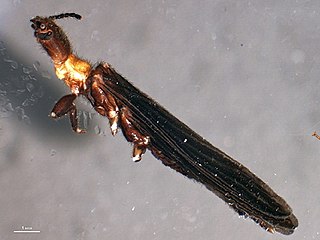
Antipaluria urichi is a species of webspinner in the family Clothodidae. It is found in the Caribbean region and South America, the type locality being the island of Trinidad.













